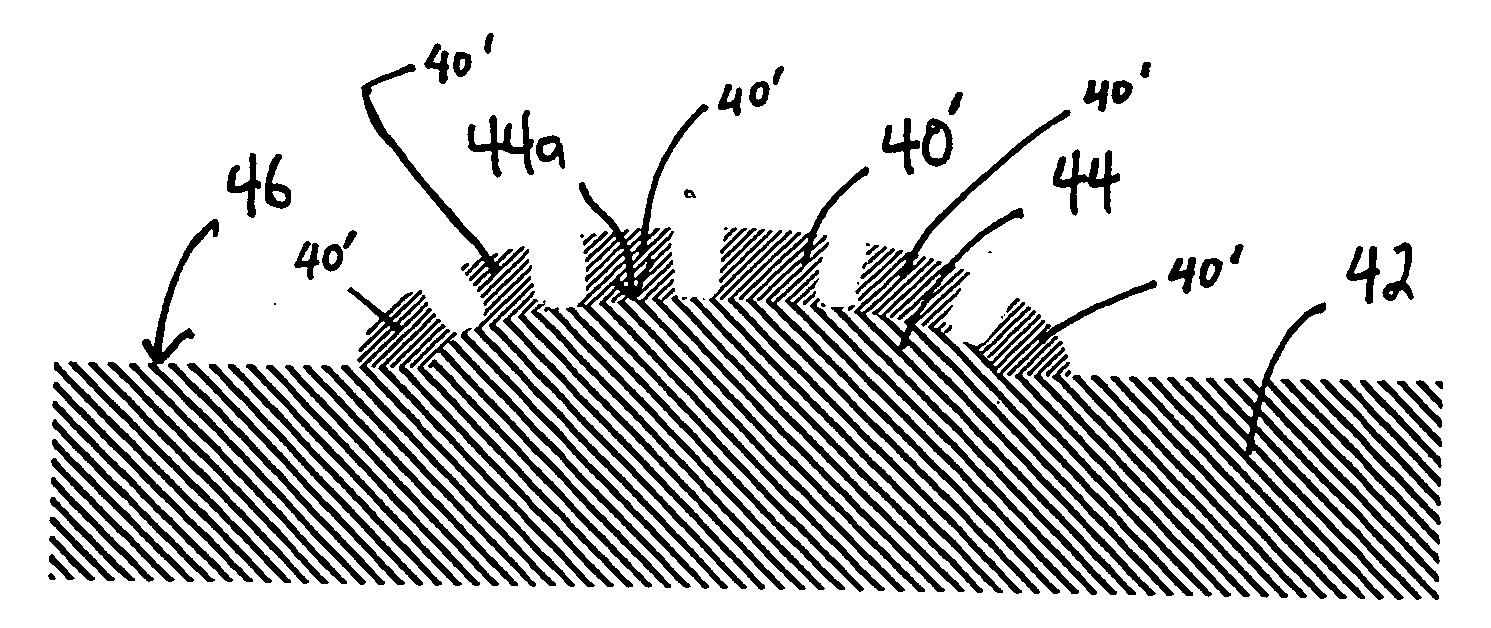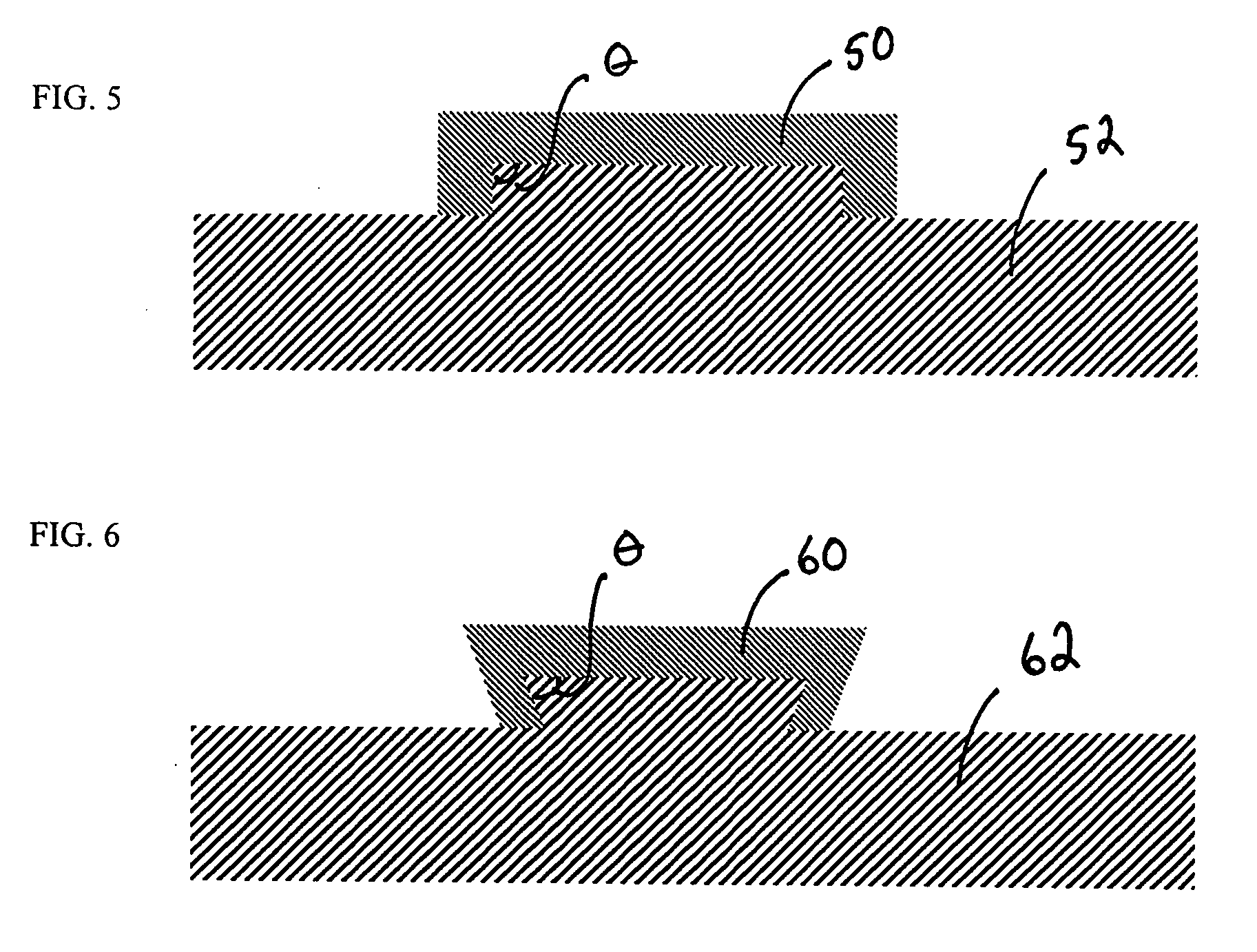High-current traces on plated molded interconnect device
a technology of high-current traces and interconnect devices, which is applied in the field of high-current traces on plated, can solve the problems of limiting the width of the trace, the cost of the plating process usually limiting the depth of the trace, and the cost of the plating process
- Summary
- Abstract
- Description
- Claims
- Application Information
AI Technical Summary
Benefits of technology
Problems solved by technology
Method used
Image
Examples
second embodiment
[0024]A high-current trace 30 of the present invention is shown in cross-sectional view in FIG. 3. Molded interconnect device 32 is preferably made of a photosensitive material by a one-shot molding process. MID 32 has an interconnect pattern that is a channel 34, having surfaces 34a, 34b, and 34c, which in this embodiment are flat, recessed into the substrate surface 36 of MID 32. In this embodiment, channel 34 is trapezoidal in cross-section. A conductive material 35, preferably copper, is grown on surfaces 34a, 34b, and 34c, which in this embodiment are flat, to create trace 30. Trace 30 is preferably grown by plating onto an interconnect path written on at least a portion of the interconnect pattern. The interconnect path has been written by a laser or other illuminator as described herein. Accordingly, while trace 30 has an apparent width relative to MID 32 that is approximately the same as the width of trace 10 of the prior art, and a depth of that is approximately the same as...
third embodiment
[0025]In yet another embodiment, a curved surface is used. A high-current trace 40 of the present invention is shown in cross-sectional view in FIG. 4. Molded interconnect device 42 is preferably made of a photosensitive material by a one-shot molding process. MID 42 has an interconnect pattern that is a raised rib 44 protruding from the substrate surface 46. In this embodiment, rib 44 is ovate in cross-section and has a surface 44a, which in this case is a single, curved surface. A conductive material 45, preferably copper, is grown on surface 44a, to create trace 40. Trace 40 is grown preferably by plating onto an interconnect path written on at least a portion of the interconnect pattern. The interconnect path has been written by a laser or other illuminator as described herein. Accordingly, while trace 40 has an apparent width relative to MID 42 that is approximately the same as the width of trace 10 of the prior art, and a depth of metal that is approximately the same as the de...
first embodiment
[0034]The interconnect path of trace 20 is then written on rib 24 (Step 103). In a first embodiment, a focused laser is used. The laser beam breaks the metal atoms from the organic ligands of the organic metal complex, or reduces the metal of the spinel-based metal oxide, and creates a microscopically irregular surface. The laser beam preferably writes the interconnect path on all three protruding sides 24a, 24b, 24c of rib 24. If necessary, MID 22 can be rotated, tilted, or otherwise oriented with respect to the laser source to ensure proper laser marking of all portions of surfaces to be plated. The laser beam can also write the interconnect path on only portions of the surface of rib 24 if desired for the end application.
[0035]MID 22 is next cleaned to remove debris (Step 105), preferably by use of demineralized water. Next, trace 20 is grown on the interconnect pattern by immersion of MID 22 in a current-free bath, preferably a current-free copper bath (Step 107). The metal will...
PUM
| Property | Measurement | Unit |
|---|---|---|
| Angle | aaaaa | aaaaa |
| Current | aaaaa | aaaaa |
| Electrical conductor | aaaaa | aaaaa |
Abstract
Description
Claims
Application Information
 Login to View More
Login to View More - R&D
- Intellectual Property
- Life Sciences
- Materials
- Tech Scout
- Unparalleled Data Quality
- Higher Quality Content
- 60% Fewer Hallucinations
Browse by: Latest US Patents, China's latest patents, Technical Efficacy Thesaurus, Application Domain, Technology Topic, Popular Technical Reports.
© 2025 PatSnap. All rights reserved.Legal|Privacy policy|Modern Slavery Act Transparency Statement|Sitemap|About US| Contact US: help@patsnap.com



